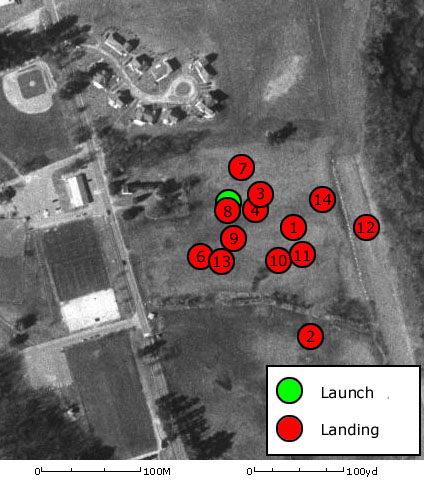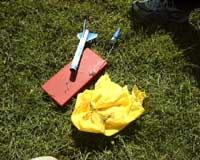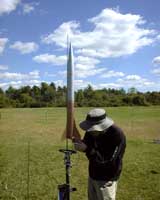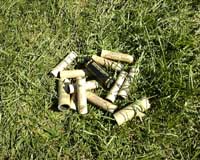Launch Report: September 15, 2001

For my first flight, I put a B6-4 in the Pip Squeak to see how it handled in the lack of wind, hoping for a NARTREK bronze streamer duration attempt. The flight was perfect but fell short of the required 30 seconds with a duration of 24.3 seconds. Next, with the ulterior motive of breaking or losing the Astra I, I loaded it up with a C6-5 just to see where it would go. The C engine is great fun to watch because of its long burn time. The deploy was perfect, and a light breeze carried it a long way. It was in the air forever - long enough for me to jog out to the next field and catch the rocket on its way down. Having warmed up with my two small rockets, I moved on to the freshly painted Phoenix. It's a really great looking rocket, probably my favorite, and on the slightly under-powered D12-3, it takes off slow and looks wonderful. Unfortunately, its balsa fins leave something to be desired. The landing broke one of the rear fins in half. I applied some CA to it for a field repair and left it to dry while I flew other rockets. After the Astra's really long last flight, I wanted to try for the NARTREK parachute duration flight. However the last flight was on a C and I would have to compensate for the motor downgrade to a B6-4 by enlarging the parachute. I replaced its worn 12" nylon chute with a spare Aerotech 24" nylon parachute I had in my field box. This parachute was far too large for the body tube I had to work with, but after some careful folding and stuffing I managed to get the nosecone on. The ascent looked great, and the deploy occured right at apogee, but the chute got tangled for the first 15 seconds of descent. After the chute finally opened up, the Astra descended at a fantastically slow rate, but the tangle lasted just long enough to prevent me from making the 60 second NARTREK requirement. Flight duration: 57.6 seconds. How frustrating! Not to be deterred, I loaded another B6-4 into the Astra I and tried it again. This time, I must have packed all the shock cord above the very-tightly-packed parachute, because at deploy the recovery elastic snapped and the chute got some rather large holes melted in it. The body, now separated from the parachute, fell ungracefully to earth while the nosecone took its time getting down on the melted 24" chute. 
The Astra I post-separation. Taking a break from my NARTREK endeavors, I decided it was time for the maiden flight of the Initiator - my first Aerotech kit, first composite engine, first E flight, and [in my humble opinion] the most impressive rocket flight of the day. The white lightning propellant in the E15-4W leaves a flame tail about 20cm long, is extremely loud, and got lots of heads turning. The recovery worked great [didn't even push the wadding out or burn it], though it angled out over the cars and nearly went in someone's sunroof on landing. 
Attaching leads to the copperhead ignitor on my Aerotech Initiator. Returning to the smaller rockets, I put a C6-5 in the Pip Squeak. This was about the largest motor you can put in this minimum-diameter 18mm rocket. There was no wind at all at this point, so I figured what the heck. It went extremely high. The rocket came almost straight back down and landed about a meter from John Buscaglia, near the launch pads. By now the glue on the Phoenix had dried to a reasonably strong state and I decided to launch it again. This time, I was going to catch it to prevent the fins from suffering further impact. Another great looking flight, but unfortunately it came down right in the center of the launch pads - a place I couldn't run in to to grab it mid flight, so I had to let it land again and it broke the same damn fin again. I gave it another liberal helping of CA and left it to dry again. I wanted to try a NARTREK streamer duration flight again since the last one was only 5.75 seconds short and there was less wind now. I put another B6-4 in the Pip Squeak and let her rip. Immediately after leaving the pad the rocket went wildly unstable, flying in a wide vertical helix and then arcing over and powering into the ground right next to some kids, where it proceeded to blow the ejection charge all over them. Whoops! No idea what went wrong; the rocket showed no signs of damage, the engine looked like it had burned normally, and the launch rod was normal as well. I talked to Bill Spadafora about it and the only thing we could come up with was slight nozzle failure that led to vectored thrust, but you sure couldn't see any signs of it looking at the nozzle. Now I was left with few options. The Phoneix was still drying, the Astra was still broken, and I was out of motors for the Initiator. Hesitant to put another strong motor in the Pip Squeak, I loaded it up with an A8-3 to test its stability. It flew completely normally, reinforcing my feelings that the previous unstable flight was caused by a bad motor. Not wanting to just fly the Pip Squeak for the rest of the day, I set myself to repairing the Astra I. I retied the shock cord with a big fatty knot that I hoped would hold and gave it back its original 12" nylon parachute. I hadn't used any of my supply of C6-3's yet, so I loaded it up with one. It was a great flight with perfect recovery. The lack of wind allowed me to catch the rocket without having to even jog. At some point, probably at liftoff, one of the fin decals got torn off the rocket. They are ugly anyway; good riddance. Both times I've flown the Astra I on a C engine it has stayed up for almost 90 seconds, so I decided to give it a go on a B6-4 with the 12" parachute for a NARTREK parachute duration attempt. The flight was great and during recovery it must have hit some thermals or something because it stayed aloft for 72.3 seconds! My first successful NARTREK goal. Back to the streamer duration attempts, I put another B6-4 in the Pip Squeak and gave it a shot. It stayed aloft for 24.3 seconds, exactly the duration of the first B6-4 shot of the day, and just as short of 30 seconds. On landing it knocked a fin off too. Damn; I liked that paintjob and now it's got a big crack in it around one fin. Gave it the field CA repair job and set it aside to dry. The Phoneix was marginally dry, and I wanted to get at least one more NARTREK objective taken care of, so I launched it again on a D12-3 and angled the launch rod slightly away from the pads and downwind so I could be sure to catch it. The flight was another great one, and I managed to catch it which qualifies as a successful "D" engine flight and another NARTREK goal achieved. Half way to Silver! 
The pile of spent motor casings I accumulated over the course of the day. With that, it was already 3:00pm and the launch was over. Nicely sunburned, Mikkel and I returned to Cambridge for chinese food. Good launch. | |||||||||||||||||||||||||||||||||||||||||||||||||||||||||||||||||||||||||||||||||||||||||||||||||||||||||||||||||||||||||